The Corrective and Healing Nature of Black Dolls

Growing up, the fairytales I heard were almost exclusively about white princesses and damsels in distress. These stories had a profound impact on my self-esteem, which is something I realized while teaching children to make dolls at the Anacostia Community Museum in Southeast Washington DC in 1998. I noticed that Black and Brown children were choosing skin, eye, and hair colors that did not match their own, simply because those were the people they had seen in the media and film. This lack of positive representation led them to question their own beauty and abilities.
When I thought of the harmful effects this was causing, as in low self-worth, I began to explore how to change the negative thoughts we might have of ourselves despite the images posed by the world. I thought about how I could help each person create a positive image of themselves that was also beautiful. I knew doll-making would be my medium to use. I made my own doll clothes as a kid and I also made my own rag dolls. People loved it when I made a doll for them in their own image and I saw how they’d light up. I was getting such pleasure and healing whenever I made a doll that I began to pay attention to how it felt to me as the doll began to look like the person. Because I could feel the love myself, it was clear to me that others would also.
Black dolls have been widely used by people of color throughout history as a way to heal from the negative effects of racism and other forms of discrimination.1https://kennethclark.commons.gc.cuny.edu/the-doll-study/, Different and Wonderful: Raising Black Children in a Race Conscious Society, by Darlene Powell Hopson, Derrick Hopson, Touchstone (February 15, 1992)
“No matter what we look like, if we were born and raised in America, white-body supremacy and our adaptations to it are in our blood. Our very bodies house the unhealed dissonance and trauma of our ancestors,” —Resmaa Menakem, My Grandmother’s Hands.
Finding a doll that looked like me was not easy. During my childhood in the 1970’s black dolls were not commonly produced by doll manufacturers or portrayed in the media. Consequently, my mom would buy dolls and holiday figures such as Santa Claus’ and paint them brown. She was not only trying to help me see myself in images but was also uplifting her own self-esteem.
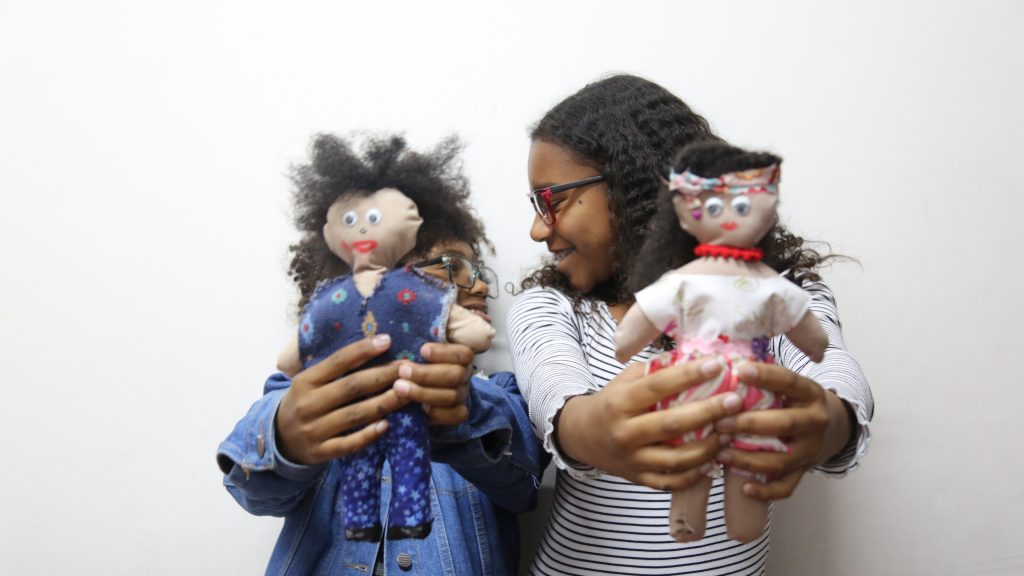
I saw in my beautiful mother the pain and trauma of colorism. She did not know how beautiful she was. Her beautiful dark brown skin was never admired when she was growing up, instead, it was compared to the lighter complexion of girls and women in her family. Eventually, people would notice and say things like, “You’re pretty for a chocolate girl,” or “You’re dark-skinned but pretty.” Coupled with comments on looks was the association of dark being evil and or mean. These and more affected her and I saw her trying to protect me from the same thing happening to me.
“The matter of color, quiet as it is kept, is still an issue among us. Color still affects our thoughts, attitudes, and perceptions about beauty and intelligence, about worth and self-esteem.” —Alice Walker (1982). Essence 2Walker A. (1982, July). Embracing the dark and the light. Essence, pp. 67, 128.
Additionally, I wanted to address the commodification and appropriation of African, African American, and Latina bodies through social media. These bodies and complexions are often hyper-sexualized and treated like a passing trend, such as Brazilian Butt Lifts or BBLs as they are commonly known. BBLs are a trend for now, but they mimic the natural bodies of women of African descent, which have been made popular by social media. When the trend fades, women of African descent will still have their natural bodies, while others can opt to have the procedure reversed and return to their original bodies.
“We all have a story. My mother suffered. We can go all the way back to when she was a child and people told her her nose was too big, her skin was too dark, her lips were too wide. It’s very important the world acknowledges my mother was a classical musician whose dreams were not realized because of racism.” —Simone Kelly, daughter of Nina Simone.
I just wanted to change all of this. I saw the beauty in everyone from Black to White and I thought if each of us could see this beauty inside and out then we could be more confident, more successful, less judgmental, and more kind to each other. Obviously, the Black and Latino plight in this was at the forefront of my mind. So, I created the Ragbaby Exchange, which is an organization that uses doll-making to heal and build a sense of self-worth in each participant.
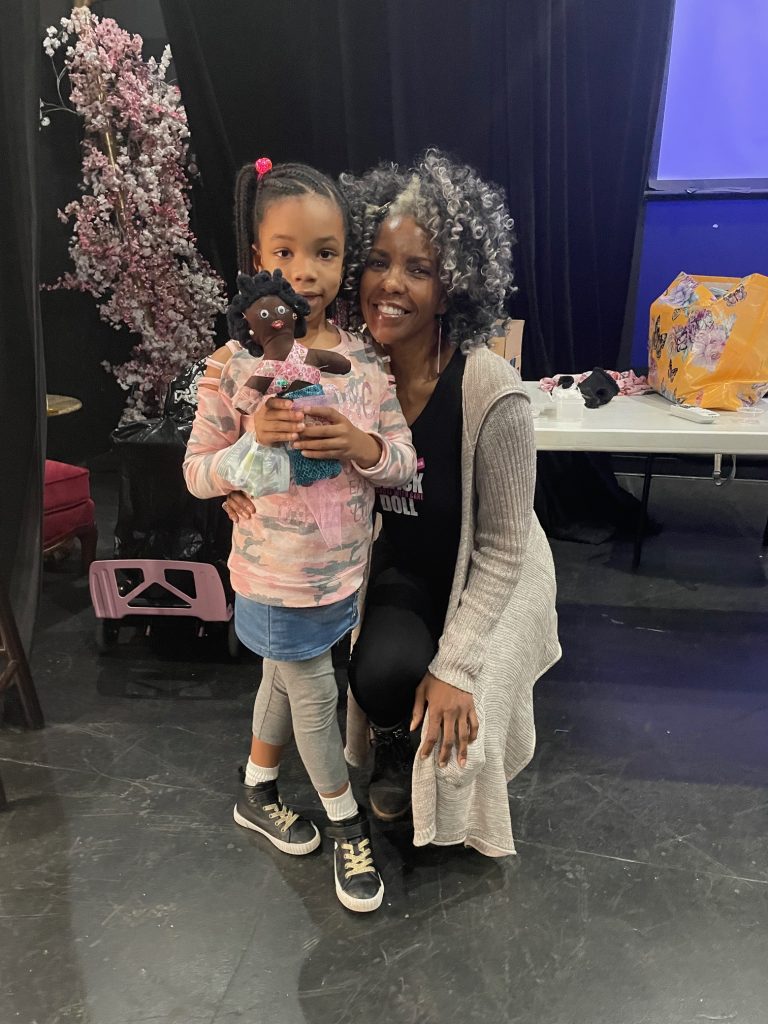
How can doll-making become radical self-love and healing justice? I devised a series of steps to create a doll. The first thing that is also the most important is choosing the fabric color to represent the complexion. Because once one can see their skin tone beautifully made, the outside thoughts disappear. After that I wanted the doll to be a vessel that one filled with love and used to release negative thoughts. As a ritual, I had people write down the negative self-talk in their heads, what they heard others say about them, and what they internalized from the media and family, and then tear them up, literally shred the words. From there we would rewrite those thoughts in the affirmative and stuff these affirmations directly into the dolls. Something so simple becomes an emotional release for many, including me. I healed myself each time I created a doll this way. When I realized this healing approach, I began to think of ways to add more to the creation of dolls. I researched and studied ways to build self-esteem. I learned how to manifest ideas of self-worth. Through many books and talks and my own experiences, I was able to connect the idea of using affirmations in my doll-making to lift the self-worth of others.
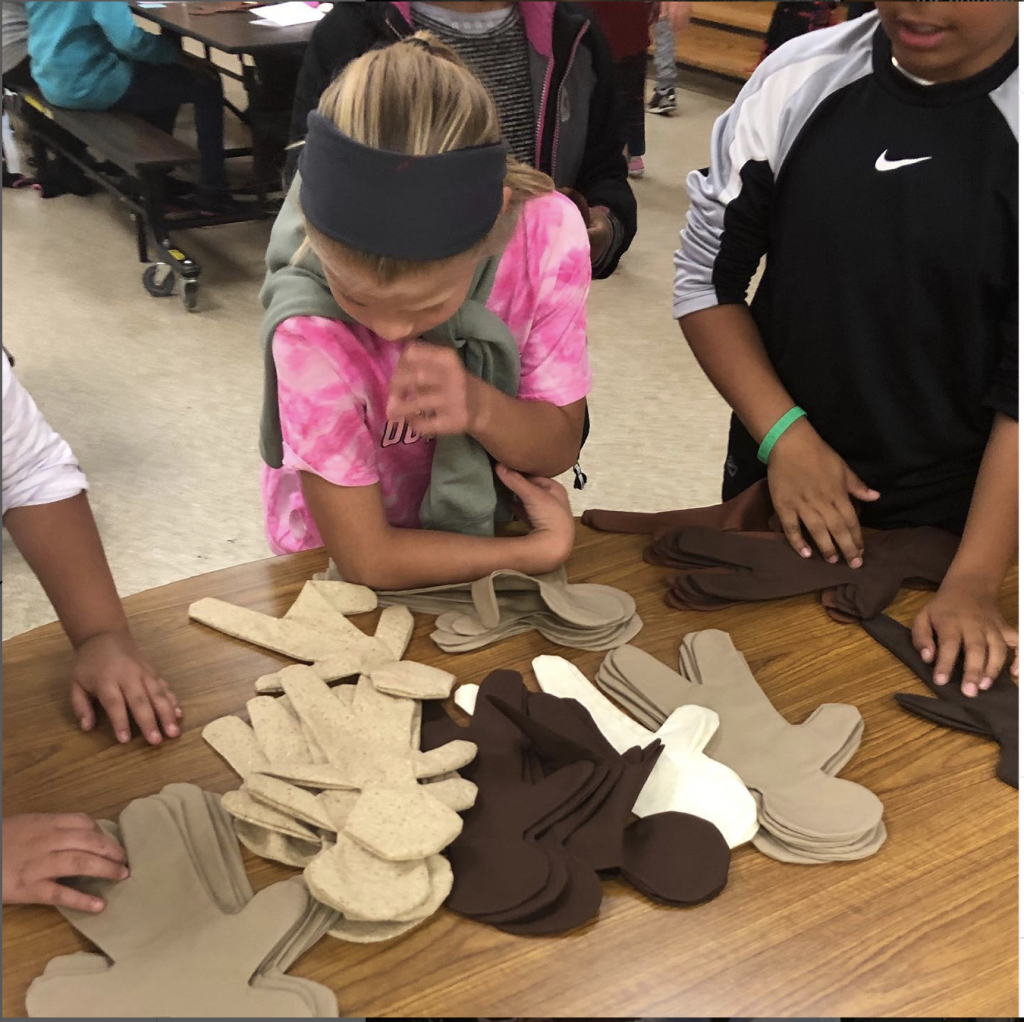
Dolls are like a little part of you. You can craft a doll into what you want to be or feel. So why not craft yourself into love? Lovingly stitching each part of it is meditative. And dolls are malleable, I like to have people find where pain may be in their body on the doll. Here I encourage people to stitch it, put flowers or hearts on it, pray, or send love to the area. I have them pay attention to their bodies, what are they thinking about their size, what trauma has occurred, and ask the question: what does it need to heal? And we do that thing they need for the doll, a hug? Then we’ll hug the doll, punch, sing, cry, and laugh until there is satisfaction or release. We continue with clothing and make the outfit without worrying about if, it is perfect. Just create it with beautiful fabrics, let this be a joy and not judgment from others. We move on to the hair. Hairstyle and texture are another point of healing especially for African Americans. I use all types of yarns, fabric, and even weave hair. Helping people choose their texture, which can sometimes be hard, leads to conversations about the pain and the places that have not allowed us to have our hair the way it grows out of our heads. We then come to the face, it is often by this time that the beauty of the doll is beginning to emerge and the participant is starting to fall in love with themselves. Painted, glued or no face lips are always added. Large lips are expressed as well as tiny thin lips. At the end, we like to have each person express their journey in creating their doll. We also have others write a message of love about that person on heart-shaped paper. Often people pin the hearts right onto their dolls.
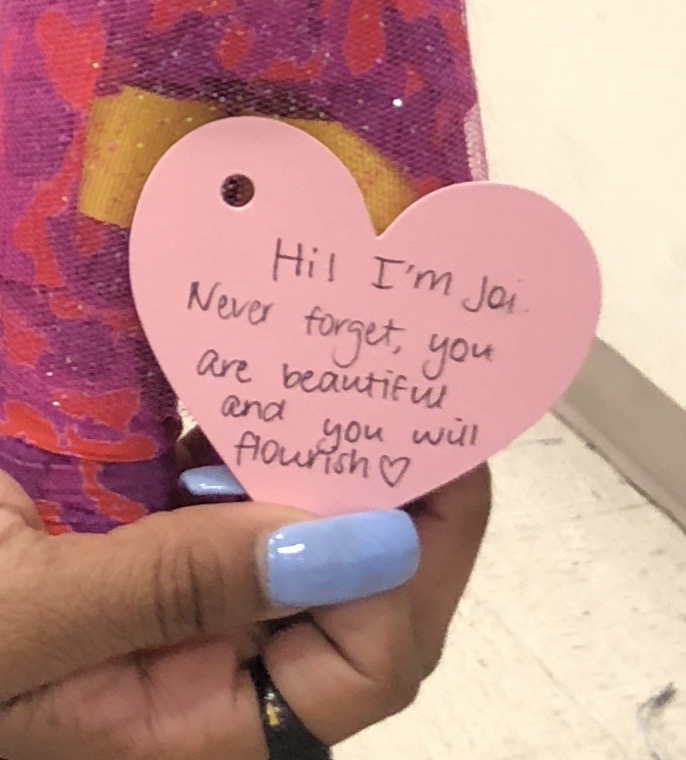
I have created all sorts of workshops using these techniques. One is the Raising a Superhero (RAS) workshop. I found so many children who also see the Superhero in the media not only as a white man but as another person coming to their rescue. In this workshop, children learn through powerful words and understanding what bullying does and how to be their own Superhero. They choose what would make them happy to do in the world and how they could help a kid that feels like them. Then they create their Superhero into who they want to be with all the tools they need to carry out what they love.
“By identifying with our cultural heroes and superheroes, children can begin to feel like they are aligning with what is good and can develop their own power and value in the world.” —Jeff Greenberg, Social Psychology Professor at the University of Arizona.
Issues of colorism extend well into the diaspora. I had the opportunity to go to Cuba and do Raising a Superhero Workshop with Afro Cuban School children. I learned how the concept of race is interpreted differently outside of the US. Because of the history of the mixing of races, lighter-skinned Cubans are not characterized as fully Black or fully White. Only dark-skinned Cubans are referred to as Black. And though Cuba is often thought of as a raceless society, darker Cubans still deal with racism. It is hard to find Black dolls in Cuba and when you do they can be very expensive. During the workshop, when offering the doll bodies in differing complexions to choose from, many of the children reached for “Blanca”, the White-colored dolls, despite their range of skin colors. When asked why, it was often said that Black was bad and meanwhile white was sweet and pure. In further probing, I asked what they thought of themselves as Black Cubans and they sometimes did not like that label because they are taught that they are a raceless society despite the different treatment they experienced. Once we talked about the impact of social constructs and colonial ideals, they seemed to understand more. One little girl talked about being made fun of because of her hair texture. Though her hair appeared soft and had a wavy tight curl, it was very long and styled in two braids that reached to her lower back, she said people would remark that it was not straight enough and it hurt her. But as we created her doll, with two long thick braids, she said that she would want other little girls to see that their hair was beautiful like hers. She said. “I never ever thought I would make a doll that looks like me and be so beautiful!” She became her own superhero that day. She would use her powers to help other little girls. In still another workshop there was Sami. He had the darkest skin tone of any of the other kids. He was very uncomfortable because most of the other students knew each other and he was an addition to the class at the last minute. As we passed around the dolls the kids, once again, went for the lightest of complexions. We stopped and talked to some, helping them choose complexions near their own skin colors. At Sami’s turn, he chose not white but a very light skin tone. There were snickers in the class, but I gently told him I thought his skin color was beautiful and came from a country of Kings. He did choose closer to his color bashfully. As we went through the steps to create his superhero he got more and more into it. At the end of the class, Sami took pictures with me. He said he was so happy. The next day he returned with a gift for me, a drawing, and a note that said, I was his superhero.

The healing power of black dolls is not solely limited to children. People of all ages can benefit from using black dolls as a way to heal from the emotional and psychological traumas that have been caused by racism and other forms of discrimination. The process of doll-making encourages adults to explore a range of perceptions and emotions. A young African-American adult in a detention center took a doll-making class. She was thinking how stupid it was to be making a doll when she was in detention. As she picked the fabric color to match her skin tone, she pondered which color really matched her skin. She was making this doll from the inside out. It was not dipped in brown paint, it was brown through and through. The act of stuffing the doll was therapeutic, she delicately stuffed the doll with affirmations and love notes she wrote to herself and she said aloud, “No one has ever put love inside of me, I want to make sure I put love inside of my baby daughter!” She concluded that she could create herself into anything she wanted.
In conclusion, the use of black dolls has a powerful healing effect on people of color. By providing representation, shifting negative perceptions, and boosting self-esteem, black dolls have the potential to help individuals overcome the negative impacts of racism and other forms of discrimination perpetuated by media and colonization. As such, they are an essential tool for healing and promoting positive mental and emotional well-being. I hope that the dolls I create bring beauty and healing to all who view them. I also hope that anyone who takes my workshops and follows the steps will find the inner love for self that is their birthright no matter the color of their skin.
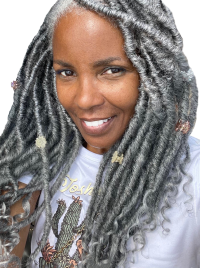
Sherri Roberts Lumpkin, the founder and Director of the Ragbaby Exchange (RBE) a doll-making workshop that builds self-esteem in women and children. As a life-long self-love advocate and social entrepreneur, Lumpkin founded RBE in 2009. Her work uplifts people through therapeutic doll-making which they create from their soul outward, filling it with self-love. Her organization centers on women’s and children’s social and emotional well-being by connecting with diverse communities and exploring the culture of African Americans, Latinas, and the African diaspora. She has implemented programs that tether doll-making to cultural identity, uplifting BIPOC and the imperatives of social justice. She was recently selected as Scholar-in-Residence for El Proyecto La Muneca Negra in La Lisa, Havana Province, a project focused on the art of dollmaking in Cuba. She’s an Artivist Fellow with Social Art and Culture in collaboration with Aspen Ideas Environment, focused on Arts and Environmental Justice in communities of color.
- 1https://kennethclark.commons.gc.cuny.edu/the-doll-study/, Different and Wonderful: Raising Black Children in a Race Conscious Society, by Darlene Powell Hopson, Derrick Hopson, Touchstone (February 15, 1992)
- 2Walker A. (1982, July). Embracing the dark and the light. Essence, pp. 67, 128.
